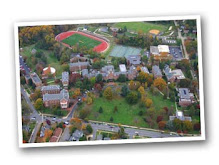 On this page the hot spot involves information regarding the college or lack of a college a student's family has attended. If a student applies to a college where a parent or sibling has graduated from or is attending, then you become a legacy student, a legitimate hook.
On this page the hot spot involves information regarding the college or lack of a college a student's family has attended. If a student applies to a college where a parent or sibling has graduated from or is attending, then you become a legacy student, a legitimate hook. In a recent interview, Maria Laskaris, Dean of Admission at Dartmouth College, was asked about legacy applicants. Here is her response:
We give all legacy applicants at least one additional review in this process. The dramatic increase in selectivity that we’ve experienced makes the admissions process more competitive for everyone, but our legacy applicants are admitted at a rate that’s roughly two-and-a-half times greater than the overall rate of admission. It’s never easy to turn away the children of Dartmouth alumni.
(To read the entire interview with Dean Laskaris click here).
Page #3: Education/Academics
 The first arrows above are for information regarding Casady School. Make sure you know what type of school you come from and get the basic information about the college counseling office from your counselor (Casady is an independent school, by the way).
The first arrows above are for information regarding Casady School. Make sure you know what type of school you come from and get the basic information about the college counseling office from your counselor (Casady is an independent school, by the way).Now on to other hot spots and hooks.
Grades and test scores. We encourage our students not to record their GPA or test scores. We send official transcripts and students must submit official test scores (via ACT or College Board). If, however, the student's test score is big, then it is worth including, because a big test score (i.e. 34 ACT or 1540 SAT) is a possible hook. Colleges like big numbers. It ultimately helps their US News and World Report rankings.
Current Courses. A multiple choice question.
Among the following, the biggest reason that capable students might not get into selective schools is:
A. They don't have the right contacts.
B. The admission committee failed to recognize the strength of their credentials.
C. They made unwise choices regarding classroom performance.
D. Their scores were too low.
If you picked D, you are correct.
What a senior decides to take their senior year does in fact count. It's a myth to believe that a senior can "coast" or let up. Selective colleges want to see that seniors challenges themselves appropriately.
Rule of thumb: Seek to take the next level of rigor in each core academic subject.
(English 3 to English 4, AP US History to AP Government/AP European History, Chemistry to Physics, Spanish III to Spanish 4, etc.)
One caveat: If you apply Early Action or Early Decision, the chances are that the school you apply to will not see your first trimester (or semester) grades, but they will see the courses you took in the first trimester. Now if your application gets deferred, then these schools will see two trimesters of grades. Often the reason that a student gets deferred is because these colleges want to see more grades.




























